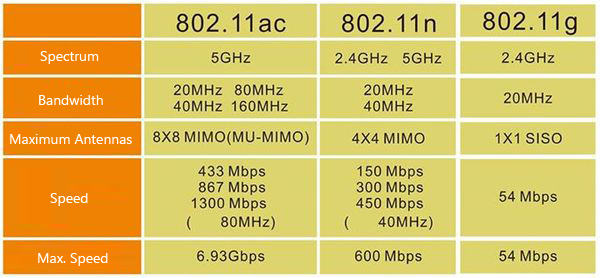
Understanding the Wi-Fi technology for video surveillance
Nowadays, Wi-Fi is everywhere, it becomes the universal feature that your indoor network cameras supported. Compared with wired Ethernet connection, WiFi wireless technology offers a flexible, cost-efficient and quick way to deploy cameras for your video surveillance systems. Using WiFi, there would be no need to pull a cable through the wall or ground. As the pioneer network camera manufacturer, Unifore provides security cameras with built-in WiFi support. However, do you really know some basic information about WiFi technology? Let's explain the WiFi technology with you.
What's 802.11 WLAN standards?
The most common WiFi standard for wireless local area networks (WLAN) is the 802.11 standard by IEEE. Currently, there are four extensions of the 802.11 standard including 802.11b, 802.11g, 802.11a, 802.11n and the latest 802.11ac. Different standards can provide different data transmitting speed, meanwhile offer additional data encryption. 802.11 standards operate in a license-free spectrum, including 2.4GHz and 5GHz.
802.11b, which was approved in 1999, operates in the 2.4 GHz range and provides data rates up to 11 Mbit/s. Until 2004, most WLAN products sold were based on 802.11b. 802.11g, which was approved in 2003, is the most common 802.11 variant on the market. It operates in the 2.4 GHz range and provides data rates of up to 54 Mbit/s. WLAN products are usually 802.11b/g compliant.
802.11a, which was approved in 1999, operates in the 5 GHz frequency range and provides data rates of up to 54 Mbit/s. An issue with the 5 GHz frequency range is that it is not available for use in parts of Europe where it is allocated for military radar systems. In such areas, 5 GHz WLAN components should conform to 802.11a/h standard.
Another disadvantage with 802.11a is that its signal range is shorter than 802.11g’s because it operates on a higher frequency; consequently, many more access points are required for transmission in the 5 GHz range than in the 2.4 GHz range.
802.11n, which is the current standard that will enable data rates of up to 600 Mbit/s. The newly developed products supporting 802.11n data rates of up to 300Mbit/s.
802.11ac is the new 5th generation Wi-Fi standard in the 802.11 family (which is marketed under the brand name Wi-Fi). 1.3Gbps is the speed most commonly cited as the 802.11ac standard. This translates to 166MBp/s or 1331Mbp/s. It is vastly quicker than the 450Mbit/s headline speeds quoted on the highest performing 802.11n products.

Due to the nature of wireless communications, anyone with a wireless device that is present within the area covered by a wireless network can share the network and intercept data being transferred over it unless the network is secured. To prevent unauthorized access to the data transferred and to the network, some security technologies such as WEP and WPA/WPA2 have been developed to prevent unauthorized access and encrypt data sent over the network.
What's WEP (Wired Equivalent Privacy)?
WEP prevents people without the correct key from accessing the network. There are, however, weaknesses in WEP. They include keys that are relatively short and other flaws that allow keys to be reconstructed from a relatively small amount of intercepted traffic. WEP today is no longer considered to provide adequate security as there are a variety of utilities freely available on the web that can be used to crack what is meant to be a secret WEP key.
What's WPA/WPA2 (WiFi Protected Access)?
WPA significantly increases security by taking care of the shortcomings in the WEP standard. WPA adds a standard way for distributing encrypted keys.
Some security guidelines when using wireless cameras for surveillance:
- Enable the user/password login in the cameras.
- Enable the encryption (HTTPS) in the wireless router/cameras. This should be done before the keys or credentials are set for the WLAN to prevent unauthorized access to the network with stolen credentials.
- Ensure that wireless cameras support security protocols such as IEEE 802.1X and WPA/WPA2.
Get My Latest Posts
Subscribe to get the latest updates.
Your email address will never be shared with any 3rd party.
Scan me




